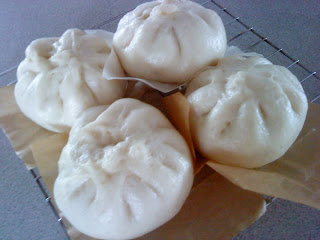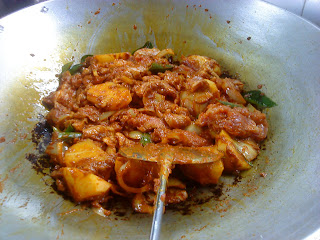This is my Ma's own version of the dish. She adds in eggs and beancurd for more variety and to reduce the quantity of pork. It's 'kocha' style.
During the 1950's, not everyone can afford to eat pork or chicken everyday especially for the poor. My grandpa used to buy the leftover pork from the butcher and cook in big quantities.
My Ma says the family can eat this dish with plain rice, porridge, buns and even fresh bread [roti benggali]. She told us that when the butcher has too much leftovers and when my grandpa could not afford to buy, the butcher will suggest betting. My grandpa will get the pork free if he wins and pay less if he loses.

During the 1950's, not everyone can afford to eat pork or chicken everyday especially for the poor. My grandpa used to buy the leftover pork from the butcher and cook in big quantities.
My Ma says the family can eat this dish with plain rice, porridge, buns and even fresh bread [roti benggali]. She told us that when the butcher has too much leftovers and when my grandpa could not afford to buy, the butcher will suggest betting. My grandpa will get the pork free if he wins and pay less if he loses.

Ingredients
600 gm pork belly - cut bite size pieces
6 - 7 hard boiled eggs - shelled
5 pieces firm beancurd - cut diagonally and fried
5 cloves garlic
1 tsp white peppercorns
1-2 tbsp dark soy sauce [depends on quality]
2 tbsp sugar
4 tbsp light soy sauce
water
600 gm pork belly - cut bite size pieces
6 - 7 hard boiled eggs - shelled
5 pieces firm beancurd - cut diagonally and fried
5 cloves garlic
1 tsp white peppercorns
1-2 tbsp dark soy sauce [depends on quality]
2 tbsp sugar
4 tbsp light soy sauce
water
- Pound garlic and peppercorns into a paste. Fry beancurd, set aside. Shelled hard boiled eggs.
- Heat up a heavy base pot, put in pork pieces. Add in pounded garlic and peppercorns, dark soy sauce and sugar. Give it a stir and leave ingredients to cook till meat is firm and well coated with seasoning, about 10 - 15 minutes.
- Add in light soy sauce, eggs and enough water to cover the meat. Keep boiling for about 30 minutes then add in fried beancurd. Continue boiling till meat is tender. Add a little more water if gravy is too dry and meat is not tender. Stir a few times to prevent sticking.
- Serve with rice.

Note: Some people prefers to eat this dish with rice and sambal belacan.


















































